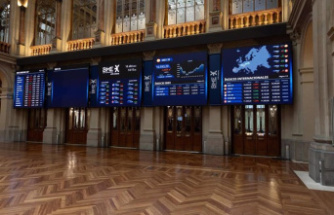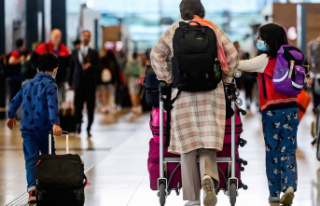The inhabited territories of Quebec are increasingly vulnerable to landslides due to climate change. No less than 19,000 residences are under surveillance, as they are found in high-risk areas that have been listed by the government.
• Read also: Landslide in Saguenay: the relocation of the victims is complete
• Read also: Chicoutimi: 18 people evacuated after two landslides
The major landslide that swept away a residence at the bottom of a cliff in the borough of La Baie, in Saguenay, on June 13, forced the evacuation of 76 homes in the same area. Unfortunately, some owners will never be able to return to their homes because the risks are too high.
To date, 41 municipalities manage sectors that are located in the heart of areas exposed to landslides. According to data compiled by Le Journal, no less than 19,000 residences and more than 1,000 commercial units are currently found in these areas across Quebec, not counting municipal infrastructure, institutional buildings and vacation resorts.
These residences are mostly built on “sensitive” clay soils, prone to soil movement when disturbed.
The government ensures that these places are under surveillance and that preventive work is carried out.
Climatic changes
These natural events, having consequences on the built heritage of Quebec and the safety of the populations, are expected to increase more rapidly due to the climate crisis, say experts.
“Indeed, the vegetation changes, just like the soil”, explains Alain Bourque, general manager of Ouranos, a consortium on regional climatology and adaptation to climate change.
According to the Canadian Geoscience Education Network, fluvial erosion and increased water pressure in the ground "particularly during heavy rains or rapid snowmelt" can trigger subsidence.
“It means that a shift that should perhaps have taken place in 2085 could take place now. We can imagine that by 2100 there will be many more people who will have experienced landslides because the ground has become unstable.
Human intervention
This phenomenon is added to human activity, “such as excavation and construction work”, which usually acts as the main trigger or aggravating factor of landslides.
“Everyone wanted to have beautiful views from the top of the embankments,” points out professor emeritus Serge Leroueil. “At the time, we knew less about the risk. »
The geotechnical specialist, Mr. Leroueil believes that it “is credible” that climate change increases the risks. Increased rainfall can cause ground motions, he says, but he adds nuance; these are mostly “superficial”.
Climate analyzed
The Ministry of Public Security, for its part, ensures that its analyzes and monitoring now take climate-related risks into consideration.
“The advancement of research in the field of the impacts of climate change on certain types of landslides now makes it possible to take these parameters into account,” underlines Marie-Josée Montminy of the Ministère de la Sécurité publique.
NUMBER OF PROPERTIES AT RISK OF SLIDES IN QUEBEC
18,000 buildings*
19,000 residential units
1000 commercial units
Sources: Departments of Municipal Affairs and Housing, Public Safety, Natural Resources and Transportation
VERY COSTLY FOR THE STATE
For ten years, Quebec has spent $71 million under financial assistance programs for landslide victims and to carry out ground movement prevention work. “As part of the emergency financial assistance programs, a total amount of more than $32 million was paid to individuals, owners of rental properties and businesses in connection with ground movement files. “, relates the spokesperson for the Ministry of Public Security (MSP), Marie-Josée Montminy. In addition, 13 landslide prevention projects costing $39 million have been completed or will be completed by 2025.
HUNDREDS OF INCIDENTS
For five years, an average of 182 landslides have been recorded each year, particularly in more densely populated regions. Reports are identified by the ministry as "possible threats to life or property". Movements are occurring in particular outside the areas identified on the government map. A total of 369 individual files have been opened over the past 10 years under financial assistance programs for homeowners. An average of $87,000 per file was paid. Public infrastructure such as roads are also victims of these subsidence.
INCREASED MONITORING
The Ministry of Public Security ensures that a risk analysis for the built environment is carried out by its experts in order to “ensure safe land development”. The government determines the vulnerable zones which are then disseminated to the municipal environment through mapping. “This makes it possible to identify situations of concern where mitigation interventions are deemed necessary. Depending on the situation, financial support may be offered to the municipality and the citizens concerned to correct the situation,” explains MSP spokesperson Marie-Josée Montminy. Municipalities have an obligation to integrate it into their development plan. Quebec may request modifications for reasons of public safety.
NO IMPAIRMENT LOSS...FOR NOW
In 2018, Altus Group provided a study in Quebec City on the market value of La Baie properties located within landslide stress zones. Conclusion: there was no significant impact on the selling price. The panoramic view and the quality of the materials are the winning elements. However, in several cases, the certificate of location did not include clear information on the inclusion of residences in the zone, just like the real estate advertisements which emphasized the view. "If market participants...disregard the possibility of slippage occurring, the impact on prices may be skewed," the report said.
VULNERABLE PEOPLE
According to the list of buildings that are located in areas of constraint due to the risk of landslides, the main buildings with high density are residences for the elderly and housing cooperatives. For example, the Chartwell Domaine Cascade residence in Shawinigan has 265 units according to data from the Ministry of Energy and is in a red zone. In Alma, the CHSLD Isidore-Gauthier is also found in one of the risk areas. Vacation resorts, such as the Chalets sur le Fjord in L’Anse-Saint-Jean, are also found in these areas, as well as institutional buildings such as schools and daycare services.













